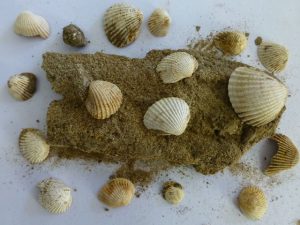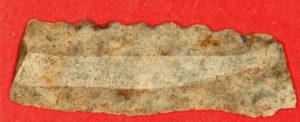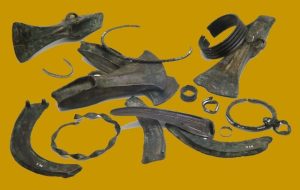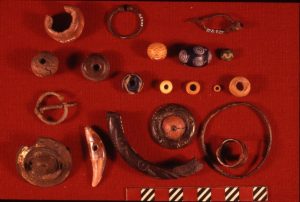
Pre-History
This page of the Avalon Marshes’ timeline covers a very long time period, from its geological roots through to the arrival of the Romans in 43 AD.
Prehistory – Early man
Palaeolithic (Old Stone Age) – 800,000-10,000 BC
Mesolithic (Middle Stone Age) – 10,000-4000 BC
Neolithic (New Stone Age) – 4000-2300 BC
Bronze Age – 2300-800 BC
Iron Age – 800 BC-43 AD
Geological time periods – The foundations
Triassic – 245-208 million years ago
Jurassic – 208-146 million years ago
Cretaceous & Tertiary – 146-2 million years ago
Quaternary – 2 million to 10,000 years ago
TRIASSIC – 245-208 MILLION YEARS AGO
Landscape & Ecology
A landscape of tropical desert and semi-desert.
History
This when the red rocks which form the foundations of the hills which flank the Avalon Marshes were laid down.
What to do / Where to go
Explore the Isle of Wedmore and Yarley Hill, take in the wonderful views of the marshes, visit their lovely villages and hamlets. Why not follow our “Wedmore, Wetlands and Sand” walking route.
Jurassic – 208-146 million years ago

Jurassic – Ichthyosaur fossil
Landscape & Ecology
A period of warm tropical seas. Ammonites, marine reptiles and others in the seas.
History
The Blue and White Lias rocks are formed. These give the local buildings their distinctive character of blue and white stone.
What to do / Where to go
Visit the Polden hills and Street where a fossil Ichthyosaur was adopted as its emblem in 1894. Cycle around the marshes and hills and look at the wonderful architecture of Blue Lias buildings. Go to our Cycling page for suggested routes and other cycling information.
Cretaceous & Tertiary – 146-2 million years ago
Landscape & Ecology
A big gap – rocks laid down, rocks eroded, major earth movements.
History
It is possible that a fault and its associated spring may be why the Tor exists as such a dramatic feature in the landscape.
What to do / Where to go
Climb Glastonbury Tor, take in the wonderful views and imagine a very different landscape. Make sure you enjoy a cream tea in Glastonbury afterwards! The Tor is on our “Glastonbury Tor to Old Oaks” walk route.
Quaternary (The Pleistocene Epoch) – 2 million to 10,000 years ago

Quaternary – Burtle sand and shells
Landscape & Ecology
Ice, erosion and dramatic changes in sea level.
History
During the inter-glacial periods the sandy gravel “islands” or Burtle Beds are formed by the action of tide and wave.
What to do / Where to go
Visit the “island” village of Burtle, look out for the sandy soils and imagine that this was once the sea! Our “Roman Saltworks & Peat Moors” cycle route is a good way to see the island of Burtle.
.
Prehistory – Early man : Palaeolithic (Old Stone Age) – 800,000-10,000 BC
Landscape & Ecology
A great simplification but the Avalon Marshes and the Severn Estuary were valleys and mammoth, woolly rhinoceros and hyaena roamed the landscape!
History & Heritage
Man was present but if there is any record in the Avalon Marshes it is buried deep under our feet.
Mesolithic (Middle Stone Age) – 10,000-4000 BC

Mesolithic – Microlith (saw blade)
Landscape & Ecology
The ice age ends, sea levels rise, the Avalon Marshes is flooded and filled with clays, reed marsh spreads and peat starts to form. Fish and birds start to become abundant.
History & Heritage
We know that Mesolithic man was here by the discovery of flint scrapers and other tools on the “burtles”.
What to do / Where to go
Visit the Museum of Somerset in Taunton to see the wonderful finds from this period of time. Visit Ham Wall National Nature Reserve and look across the reedbeds, this is a view similar to that 6,000 or so years ago when most of the Avalon Marshes was reed marsh.
Neolithic (New Stone Age) – 4000-2300 BC

The Sweet Track Drawing by E Mortlemans
Landscape & Ecology
As the peat layers built up and the marsh spread, brackish water was replaced by fresh. A wider variety of plants colonised the area including sedges and mosses. Eventually fen (or wet) woodland replaces much of the reed marsh. Sphagnum mosses grow and raised bogs start to form replacing the woodland. All the time the peat layers were growing thicker. Wildlife is varied and abundant.
History & Heritage
Neolithic man settles on the edges of marshes, they farm the hills and burtles. Wooden trackways are built across the wet marshes linking hills and islands. The most famous of them all, the Sweet Track, is constructed in the spring of 3806 BC. The peat preserves the trackways as well as tools and other fascinating artefacts.
What to do / Where to go
Visit Shapwick Heath National Nature Reserve and walk along the line of the Sweet Track. See a replica section crossing the reed marsh as it would have done almost 6,000 years ago. Find out more about the Sweet Track.
Bronze Age – 2300-800 BC

Bronze Age – Edington hoard
Landscape & Ecology
The raised bogs expand, climate change results in wetter conditions, cotton grass grows abundantly. Open water lies in areas near Glastonbury and north of Meare. Fish, wildfowl and mammals such as otter and beaver continue to be exploited.
History & Heritage
Further trackways are built to give access to and cross the marshes. Ritual deposits are made into the marshes including valuable bronze objects.
What to do / Where to go
Walk along the replica Meare Heath trackway on Shapwick Heath National Nature Reserve. Visit Westhay Moor National Nature Reserve to see the remains of the raised bog with its wonderful mosses and plants.
Iron Age – 800 BC-43 AD

Iron Age – Meare Lake village finds
Landscape & Ecology
Conditions are far wetter than before. The rivers Brue and Sheppey flow northwards through the Panborough gap.
History & Heritage
Iron Age people construct lake villages near Glastonbury and Meare: the former is occupied throughout the year, the latter may have been seasonal trading settlements. Dugout canoes rather than trackways are used to get around. Bones found at the lake villages show that white tailed eagle, crane, puffin and pelican are all nearby.
What to do / Where to go
Visit Glastonbury Lake Village Museum and find out more about the village and see many of the objects found, including one of the dugout canoes.